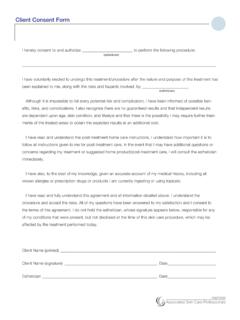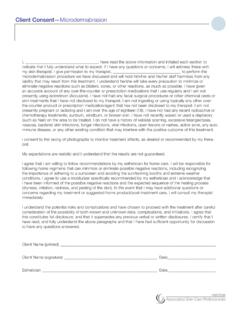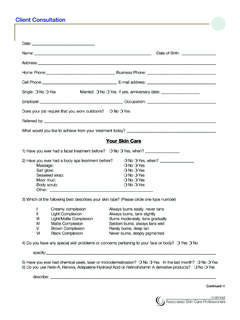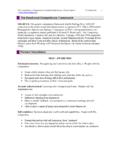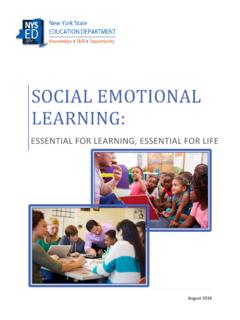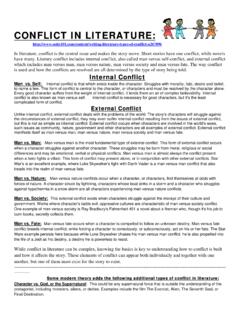Transcription of Emotional Intelligence Activities - Associated Skin Care ...
1 Emotional Intelligence ActivitiesActivity: Mood Check This activity was adapted from Quick Emotional Intelligence Activities for Busy Managers by Adele B. Lynn. American Management : Students don t always realize that bad moods are contagious and that one very stressed-out student can impact the classroom experience of everyone. This is a good exercise to use when the collective mood and motivation levels of the class drop. Goal: This exercise helps students develop more awareness of their moods and the impact of their moods on others. It also promotes a better understanding of emotions and the willingness to explore and share Emotional states with other people.
2 Through the identification of mood states, students are better able to redirect their energy and regain their motivation. Directions: Make a large Six Families of Emotion chart. It works well to produce this chart on a large poster board and laminate it. This way it can be erased and used over and overagain. A sample chart is provided at the end of this kit. students to sit in a circle with the chart at the top of the circle. Introduce the topic by asking students to think about a time they were able to sail through homework because they were excited by a project and in a great mood. Now ask them to reflect on a time when even the smallest homework assignment seemedoverwhelming.
3 Students to look at the chart and identify their present Emotional state, or the state in which they started class. by one, have students go up to the laminated chart and use a colored marker to make a dot next to the emotion that best describes how they feel. ABMP!s Student Success Curriculum, Topic 8: Motivation, page 10 Tip!Use the Mood Check activity presented here when it seems like people are starting to lose motivation for hen all the students have made their dots, discuss the findings. Here are some key questions. !As we look at the board and where people have placed their dots, what patterns do we see? !How might these Emotional patterns affect the classroom experience today?
4 !How aware of your mood were you when you walked through the classroom door? !How aware were you of the moods of your fellow classmates when you walked through the door? !Did anyone in the class influence your mood when you walked through the door? How? !W hat can we do to change the classroom mood to make it more productive? the conclusion of the exercise, go on with regularly scheduled classroom Activities . At the end of the class, ask students to describe how assessing their moods at the beginning of the class improved or worsened the rest of the classroom experience. ABMP!s Student Success Curriculum, Topic 8: Motivation, page 11 Six Fa m ilies of Em otion Cha rt (Sa m p le)HappyContent EcstaticJoyousPleasedCheerfulBlissfulExu ltantDelightedJovial Depressed SadSuicidalMelancholyGrieving GloomyMiserableHeartbrokenDistressedApat hetic Surprised ShockedDumbfoundedStartled Astonished AmazedStunnedFlabbergastedAstounded Taken AbackAnxious FearfulW orriedConcernedNervousUneasyRestlessFret fulFrightenedPanicky Angry EnragedSarcasticAnnoyed FuriousIrritatedIrateLividIncensedCross Creative Imaginative ResourcefulArtistic InspiredInnovativeIngeniousInquisitive Playful Pioneering ABMP!
5 S Student Success Curriculum, Topic 8: Motivation, page 12 Activity: Are W e P ro g re ssing ? Introduction: Students often get caught in patterns of interaction. For example, the most talkative student is always sharing and the quiet student rarely shares. Students also feel frustration with group dynamics but have no way to express it. This activity helps students express frustrations in a positive way. It also helps them see that they can impact the why the class feels and interacts. If this activity is used at all, it must be used consistently, and the results tabulated, tracked, and discussed. The students need to believe that change can happen and that progress can be made, so this activity requires a commitment from the instructor.
6 Directions: this activity after each class discussion, one time a week, or at regular intervals. It must be used at least one time a month to be effective. that most groups of people that work together for any length of time fall into regular patterns of relating. These patterns often go unquestioned even when they cause stress for certain team members. Each person is responsible for how a team relates and for their own behaviors. This activity helps us identify areas for personal growth and identify areas for team growth. out one copy of the handout to each student. Students do not place their names on the handouts.
7 Each student will place an X on one of the numbers on each continuum. Direct students to place their X directly on top of the number to avoid confusion. the students have completed the handout, ask each student to share with the group the item that the group does right and the item that the group could improve. the team progress with these questions: is our group progressing? is improving? is stagnant? is declining? each student: can our team do to make one of your scores increase? can you do on a personal level to make one of your scores increase? the handouts and calculate the averages on each continuum.
8 ABMP!s Student Success Curriculum, Topic 12, Professional Conduct & Classroom Dynamics, page the averages into a chart that is posted in the classroom. Each time the class conducts the activity, add the new averages to the chart so that the class can see if they are improving, stagnant, or declining, and which areas need work. ABMP!s Student Success Curriculum, Topic 12, Professional Conduct & Classroom Dynamics, page 11H and o u t: Are W e P ro g re ssing ? Directions: Place an X on each continuum to represent your opinion. One represents the lowest score and ten represents the highest score. I feel heard: I feel valued: M y opinions count: M y contributions are appreciated: I feel safe sharing m y ideas: I feel like I belong on the team : Describe one thing the team does right: Describe one thing the team could im prove: ABMP!
9 S Student Success Curriculum, Topic 12, Professional Conduct & Classroom Dynamics, page 1212345678910123456789101234567891012345 6789101234567891012345678910
